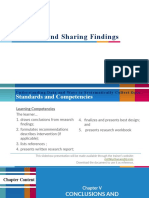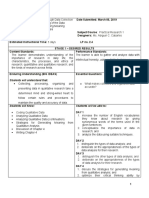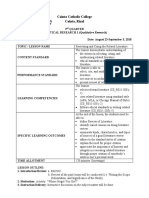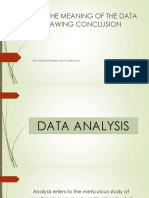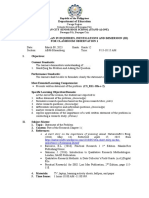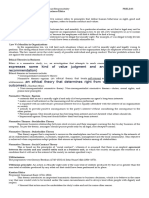0 ratings0% found this document useful (0 votes)
1K viewsLesson 10 - Drawing Out Patterns and Themes From Data
This document discusses qualitative data analysis. It describes three major styles of qualitative data analysis: template analysis, editing analysis, and immersion/crystallization analysis. It also outlines the major activities in qualitative data analysis, including coding, categorizing, identifying themes in the data, and using computer software to manage qualitative data. Finally, it provides examples of data analysis processes for specific qualitative research traditions like grounded theory, phenomenology, and ethnography.
Uploaded by
James Andrei CaguiclaCopyright
© © All Rights Reserved
Available Formats
Download as PDF, TXT or read online on Scribd
0 ratings0% found this document useful (0 votes)
1K viewsLesson 10 - Drawing Out Patterns and Themes From Data
This document discusses qualitative data analysis. It describes three major styles of qualitative data analysis: template analysis, editing analysis, and immersion/crystallization analysis. It also outlines the major activities in qualitative data analysis, including coding, categorizing, identifying themes in the data, and using computer software to manage qualitative data. Finally, it provides examples of data analysis processes for specific qualitative research traditions like grounded theory, phenomenology, and ethnography.
Uploaded by
James Andrei CaguiclaCopyright
© © All Rights Reserved
Available Formats
Download as PDF, TXT or read online on Scribd
You are on page 1/ 31
Lesson 10
At the end of the session, the learners
are able to
1.Differentiate the three major styles of
qualitative data analysis.
2.Describe the major activities and tasks in a
qualitative data analysis.
3.Summarize the specific data analysis in
different qualitative research traditions.
Loosely structured narrative materials (diaries,
verbatim dialogues) and field notes.
Qualitative Data Analysis
Involves coding and collating
Requires creativity, hardwork, and sensitivity
Labor-intensive and time-consuming
More complex and challenging
No Universal Rules for thematic or theoretical organization of
data
(Polit and Beck, 2012)
Involves a more systematic and standardized
to a more intuitive, subjective and interpretive
analysis.
Three Major Styles:
Template analysis style
Editing analysis style
Immersion/Crystallization style
Template Analysis Style
The researchers creates a template or
analysis guide to which the narrative data
are applied.
Ethnography, Ethnology, Discourse Analysis,
and Ethnoscience
Editing Analysis Style
The researcher interprets what is read
through the data searching for meaningful
segments and units.
Results to creation of codes and drawing
out of thematic categories
Grounded Theory, Phenomenology,
Ethnomethodology
Immersion / Crystallization Style
Researchers immerse in and reflect on the
text materials to develop an intuitive
crystallization of the data.
Highly interpretive and subjective
Hermeneutic or Critical Inquiries
1. Comprehending
making sense
2. Synthesizing
sifting and putting ideas together
3. Theorizing
developing alternative explanations
4. Recontextualizing
further developing a theory
Tasks:
1. Transcribing Qualitative Data
2. Developing a Categorization Scheme
3. Coding Qualitative Data
4. Manually Organizing Qualitative Data
5. Managing Qualitative Data through Computers
-Accurate verbatim description of
audiotaped interviews
- Existing transcription conventions
- I – interviewer
- P – participant
- Overlaps in speaking turns
- Time elapsed between utterances where there are
gaps, nonlinguistic utterances
- Classifying and indexing of data
- Data is converted into themes (categories,
smaller units or segments)
- Segments are compared and distinguished
with other segments
- Emerging concepts are given labels
Example
A. Use of Food Services Program C. Strategies to Avoid Hunger
1. Food stamps 1. Bargain shopping
2. Food pantries 2. Borrowing money
3. Soup kitchen 3. Getting food from friends, relatives
4. Free school lunch programs 4. Eating old and unsafe food
5. Doubling up to share food costs
6. Stretching food, smaller portions
7. Smoking in lieu of eating
8. Illegal activities, fraud
B. Food Inadequacy experience D. Special Cases
1. Problems feeding family, having 1. Mothers sacrificing for children
enough food 2. Effects of welfare reform on hunger
2. Having to eat undesirable food 3. Stigma
3. Hunger
Sorted and categorized data are given codes.
WHAT IS CODING?
CODING - an act of using symbols, like letters or
words to represent arbitrary or subjective data
(emotions, opinions, attitudes) to ensure secrecy or
privacy of the data.
Researchers highlight by coloring or using post-it
notes to collate the content of the narrative materials.
WHAT IS COLLATING?
COLLATING – a way of bringing together the coded
data. Giving the data an orderly appearance is putting
them in a graph, specifically a table of responses (data
matrix).
Researchers encode all the files to a computer and
allows a specific program to code the words, phrases,
ideas or concepts .
All coded data are retrieved and printed for analysis.
The programs do the indexing, retrieval, actual analysis and
integration of data.
Examples: The Ethnograph, MARTIN, QUALPRO, NUDIST,
HyperQual2 and ATLASTi
1. Grounded Theory
- there is comparison of elements present in one
data source to another data source
- categories, properties or hypotheses are
generated rather than testing them
- produces a conceptual or theoretical model
2. Phenomenological
a. read the entire set of protocols to get the sense
of the whole
b. discriminate units from participants’ description
of phenomenon being studied
3. articulate the psychological insight in each of
the meaning units
4. synthesize all the transformed meaning units
into a consistent statement regarding participants’
experiences; can be expressed on a specific
general level
3. Ethnographic
a. Locate an informant
b. Interview an informant
c. Make an ethnographic record
d. Ask descriptive questions
e. Analyze ethnographic interviews
f. Make a domain analysis
g. Ask structural questions
h. Make taxonomic analysis
i. Ask contrast questions
j. Make a componential analysis
k. Discovering cultural themes
l. Write the ethnography
- Involves making sense out of the data
- Occurs simultaneously with data analysis
(categorizing of data, developing themes, integrating
of themes)
- May undergo self-scrutiny, peer review or external
review
- Considers alternative explanations
You might also like
- Justification and Reason For Conducting Qualitative Research.x100% (4)Justification and Reason For Conducting Qualitative Research.x18 pages
- Designing A Research Project Related To Daily Life100% (1)Designing A Research Project Related To Daily Life18 pages
- Data Collection and Analysis Procedures: Practical Research 10% (1)Data Collection and Analysis Procedures: Practical Research 117 pages
- Practical Research 1 (Qualitative) Lesson 1 Formulating Conclusions and Rec100% (2)Practical Research 1 (Qualitative) Lesson 1 Formulating Conclusions and Rec16 pages
- Analyzing The Meaning of Data and Drawing Conclusion100% (1)Analyzing The Meaning of Data and Drawing Conclusion9 pages
- Relates The Findings With Pertinent Literature100% (2)Relates The Findings With Pertinent Literature20 pages
- Research Activity 2 Literature Review 1 1No ratings yetResearch Activity 2 Literature Review 1 16 pages
- Lesson 3: Relating The Research Findings With Pertinent Literature100% (2)Lesson 3: Relating The Research Findings With Pertinent Literature7 pages
- PR1 Lesson 8 Review of Related Literature PDF50% (2)PR1 Lesson 8 Review of Related Literature PDF3 pages
- Lesson 6-7 - (Draw Conclusions From Patterns and Themes) (Formulating Recommendations Based On Conclusions)No ratings yetLesson 6-7 - (Draw Conclusions From Patterns and Themes) (Formulating Recommendations Based On Conclusions)7 pages
- Learning From Others and Reviewing The Literature100% (1)Learning From Others and Reviewing The Literature26 pages
- q3 g11 Practical Research 1 Week 6 Module 15No ratings yetq3 g11 Practical Research 1 Week 6 Module 1521 pages
- Cs - Rs11-Iiic-E-4: Research Questions Also Has Two Types Central and Sub-Questions. Central It The Most GeneralNo ratings yetCs - Rs11-Iiic-E-4: Research Questions Also Has Two Types Central and Sub-Questions. Central It The Most General6 pages
- 6 Reviewing and Citing The Related LiteratureNo ratings yet6 Reviewing and Citing The Related Literature4 pages
- Analyzing The Meaning of The Data and Drawing100% (1)Analyzing The Meaning of The Data and Drawing12 pages
- Competencies: 1. Draws Conclusions From Research Findings Cs - Rs12-Iih-J-1 2. Formulates Recommendations - Cs - Rs12-Iih-J-2No ratings yetCompetencies: 1. Draws Conclusions From Research Findings Cs - Rs12-Iih-J-1 2. Formulates Recommendations - Cs - Rs12-Iih-J-216 pages
- Unit 4-Lesson 11-Preparing and Implementing Research InstrumentsNo ratings yetUnit 4-Lesson 11-Preparing and Implementing Research Instruments38 pages
- Q4M5 Practical Research 1 Data Patterns and Themes100% (2)Q4M5 Practical Research 1 Data Patterns and Themes23 pages
- Importance of Qualitative Research Across Different Fields100% (2)Importance of Qualitative Research Across Different Fields28 pages
- Practical Research 1 Research in Different Areas of Interest MELC5 LAS100% (2)Practical Research 1 Research in Different Areas of Interest MELC5 LAS8 pages
- Synthesizing Information From Relevant Literature Arcan0% (1)Synthesizing Information From Relevant Literature Arcan7 pages
- Applied Practical Research1 Q1 M17 Synthesizing Information From Relevant Literature100% (1)Applied Practical Research1 Q1 M17 Synthesizing Information From Relevant Literature12 pages
- Pr1 4th Quarter Week 1 8 Las Lecture For 2nd SemesterNo ratings yetPr1 4th Quarter Week 1 8 Las Lecture For 2nd Semester13 pages
- LAS in PRACTICAL RESEARCH 1 QUARTER 3 WEEK 5-6No ratings yetLAS in PRACTICAL RESEARCH 1 QUARTER 3 WEEK 5-617 pages
- Choosing Appropriate Qualitative Research Design: TargetNo ratings yetChoosing Appropriate Qualitative Research Design: Target8 pages
- (The Specificity and Feasibility of The Problem Posed) : Group 5No ratings yet(The Specificity and Feasibility of The Problem Posed) : Group 58 pages
- Inferring and Explaining Patterns and Themes From DataNo ratings yetInferring and Explaining Patterns and Themes From Data26 pages
- Guidelines in Making Conclusions and RecommendationsNo ratings yetGuidelines in Making Conclusions and Recommendations33 pages
- Lesson 5: Ethical Standards in Writing Literature Review - 0100% (1)Lesson 5: Ethical Standards in Writing Literature Review - 015 pages
- Practical Research 1 Quarter 2 - Module 8: Discovering The Power of Reason100% (1)Practical Research 1 Quarter 2 - Module 8: Discovering The Power of Reason12 pages
- 07 Practical Research 1 - Statement of The Problem100% (1)07 Practical Research 1 - Statement of The Problem2 pages
- Cs - Rs11-Iiif-J-1: General Guidelines in Writing A Literature Review100% (1)Cs - Rs11-Iiif-J-1: General Guidelines in Writing A Literature Review5 pages
- CO - Practical Research 1 (Detailed Lesson Plan)100% (1)CO - Practical Research 1 (Detailed Lesson Plan)8 pages
- Practical Research 1: Quarter 3, LAS 6: Synthesizing Information and Writing Coherent Literature ReviewNo ratings yetPractical Research 1: Quarter 3, LAS 6: Synthesizing Information and Writing Coherent Literature Review8 pages
- Practical Research 1 Quarter 1 - Module 10: Through The Slate100% (1)Practical Research 1 Quarter 1 - Module 10: Through The Slate10 pages
- Template - 4SHS-Module-Practical Research 150% (2)Template - 4SHS-Module-Practical Research 117 pages
- q3 g11 Practical Research 1 Week 4 Module 10100% (1)q3 g11 Practical Research 1 Week 4 Module 1015 pages
- Practical Research 1 Gathering Your Data: Quarter 4 - Week 4No ratings yetPractical Research 1 Gathering Your Data: Quarter 4 - Week 42 pages
- Research Across Fields: Cs - Rs11-Iiia-5 Provide Examples of Research in100% (1)Research Across Fields: Cs - Rs11-Iiia-5 Provide Examples of Research in4 pages
- Qualitative Data Presentation, Analysis and InterpretationNo ratings yetQualitative Data Presentation, Analysis and Interpretation18 pages
- Week 8 AnalyzingQualitativeData 2011 PDFNo ratings yetWeek 8 AnalyzingQualitativeData 2011 PDF35 pages
- Data Analysis in Qualitative Study and SoftwareNo ratings yetData Analysis in Qualitative Study and Software44 pages
- Data Analysis, Interpretation, and Reporting100% (1)Data Analysis, Interpretation, and Reporting25 pages
- Deep Multimodal Representation Learning A SurveyNo ratings yetDeep Multimodal Representation Learning A Survey22 pages
- Myelin - The Brain's Supercharger (PDFDrive)No ratings yetMyelin - The Brain's Supercharger (PDFDrive)324 pages
- Relation BTW Roots and Coefficients - Quadratic Equations - Class Question - JEE Main Crash CourseNo ratings yetRelation BTW Roots and Coefficients - Quadratic Equations - Class Question - JEE Main Crash Course3 pages
- Master Aerospace Engineering ASM TuDelft StudyguideNo ratings yetMaster Aerospace Engineering ASM TuDelft Studyguide110 pages
- Semillas Ecologia de La Regeneracion en Plantas PDF100% (1)Semillas Ecologia de La Regeneracion en Plantas PDF423 pages
- Lesson 3 NOTES Concepts and Theories of Business EthicsNo ratings yetLesson 3 NOTES Concepts and Theories of Business Ethics5 pages
- The Future of Artificial Intelligence in Everyday Life100% (1)The Future of Artificial Intelligence in Everyday Life2 pages
- Dissertation On Corporate Social Responsibility PDF100% (1)Dissertation On Corporate Social Responsibility PDF4 pages
- Lithium-Ion Battery System For TelecommunicationNo ratings yetLithium-Ion Battery System For Telecommunication4 pages
- Genil - Yzabel - B - Activity - 2 - in - The - Contemporary - WorldNo ratings yetGenil - Yzabel - B - Activity - 2 - in - The - Contemporary - World2 pages
- Justification and Reason For Conducting Qualitative Research.xJustification and Reason For Conducting Qualitative Research.x
- Designing A Research Project Related To Daily LifeDesigning A Research Project Related To Daily Life
- Data Collection and Analysis Procedures: Practical Research 1Data Collection and Analysis Procedures: Practical Research 1
- Practical Research 1 (Qualitative) Lesson 1 Formulating Conclusions and RecPractical Research 1 (Qualitative) Lesson 1 Formulating Conclusions and Rec
- Analyzing The Meaning of Data and Drawing ConclusionAnalyzing The Meaning of Data and Drawing Conclusion
- Lesson 3: Relating The Research Findings With Pertinent LiteratureLesson 3: Relating The Research Findings With Pertinent Literature
- Lesson 6-7 - (Draw Conclusions From Patterns and Themes) (Formulating Recommendations Based On Conclusions)Lesson 6-7 - (Draw Conclusions From Patterns and Themes) (Formulating Recommendations Based On Conclusions)
- Cs - Rs11-Iiic-E-4: Research Questions Also Has Two Types Central and Sub-Questions. Central It The Most GeneralCs - Rs11-Iiic-E-4: Research Questions Also Has Two Types Central and Sub-Questions. Central It The Most General
- Competencies: 1. Draws Conclusions From Research Findings Cs - Rs12-Iih-J-1 2. Formulates Recommendations - Cs - Rs12-Iih-J-2Competencies: 1. Draws Conclusions From Research Findings Cs - Rs12-Iih-J-1 2. Formulates Recommendations - Cs - Rs12-Iih-J-2
- Unit 4-Lesson 11-Preparing and Implementing Research InstrumentsUnit 4-Lesson 11-Preparing and Implementing Research Instruments
- Q4M5 Practical Research 1 Data Patterns and ThemesQ4M5 Practical Research 1 Data Patterns and Themes
- Importance of Qualitative Research Across Different FieldsImportance of Qualitative Research Across Different Fields
- Practical Research 1 Research in Different Areas of Interest MELC5 LASPractical Research 1 Research in Different Areas of Interest MELC5 LAS
- Synthesizing Information From Relevant Literature ArcanSynthesizing Information From Relevant Literature Arcan
- Applied Practical Research1 Q1 M17 Synthesizing Information From Relevant LiteratureApplied Practical Research1 Q1 M17 Synthesizing Information From Relevant Literature
- Pr1 4th Quarter Week 1 8 Las Lecture For 2nd SemesterPr1 4th Quarter Week 1 8 Las Lecture For 2nd Semester
- Choosing Appropriate Qualitative Research Design: TargetChoosing Appropriate Qualitative Research Design: Target
- (The Specificity and Feasibility of The Problem Posed) : Group 5(The Specificity and Feasibility of The Problem Posed) : Group 5
- Inferring and Explaining Patterns and Themes From DataInferring and Explaining Patterns and Themes From Data
- Guidelines in Making Conclusions and RecommendationsGuidelines in Making Conclusions and Recommendations
- Lesson 5: Ethical Standards in Writing Literature Review - 0Lesson 5: Ethical Standards in Writing Literature Review - 0
- Practical Research 1 Quarter 2 - Module 8: Discovering The Power of ReasonPractical Research 1 Quarter 2 - Module 8: Discovering The Power of Reason
- 07 Practical Research 1 - Statement of The Problem07 Practical Research 1 - Statement of The Problem
- Cs - Rs11-Iiif-J-1: General Guidelines in Writing A Literature ReviewCs - Rs11-Iiif-J-1: General Guidelines in Writing A Literature Review
- Practical Research 1: Quarter 3, LAS 6: Synthesizing Information and Writing Coherent Literature ReviewPractical Research 1: Quarter 3, LAS 6: Synthesizing Information and Writing Coherent Literature Review
- Practical Research 1 Quarter 1 - Module 10: Through The SlatePractical Research 1 Quarter 1 - Module 10: Through The Slate
- Practical Research 1 Gathering Your Data: Quarter 4 - Week 4Practical Research 1 Gathering Your Data: Quarter 4 - Week 4
- Research Across Fields: Cs - Rs11-Iiia-5 Provide Examples of Research inResearch Across Fields: Cs - Rs11-Iiia-5 Provide Examples of Research in
- Qualitative Data Presentation, Analysis and InterpretationQualitative Data Presentation, Analysis and Interpretation
- Relation BTW Roots and Coefficients - Quadratic Equations - Class Question - JEE Main Crash CourseRelation BTW Roots and Coefficients - Quadratic Equations - Class Question - JEE Main Crash Course
- Master Aerospace Engineering ASM TuDelft StudyguideMaster Aerospace Engineering ASM TuDelft Studyguide
- Semillas Ecologia de La Regeneracion en Plantas PDFSemillas Ecologia de La Regeneracion en Plantas PDF
- Lesson 3 NOTES Concepts and Theories of Business EthicsLesson 3 NOTES Concepts and Theories of Business Ethics
- The Future of Artificial Intelligence in Everyday LifeThe Future of Artificial Intelligence in Everyday Life
- Dissertation On Corporate Social Responsibility PDFDissertation On Corporate Social Responsibility PDF
- Genil - Yzabel - B - Activity - 2 - in - The - Contemporary - WorldGenil - Yzabel - B - Activity - 2 - in - The - Contemporary - World







